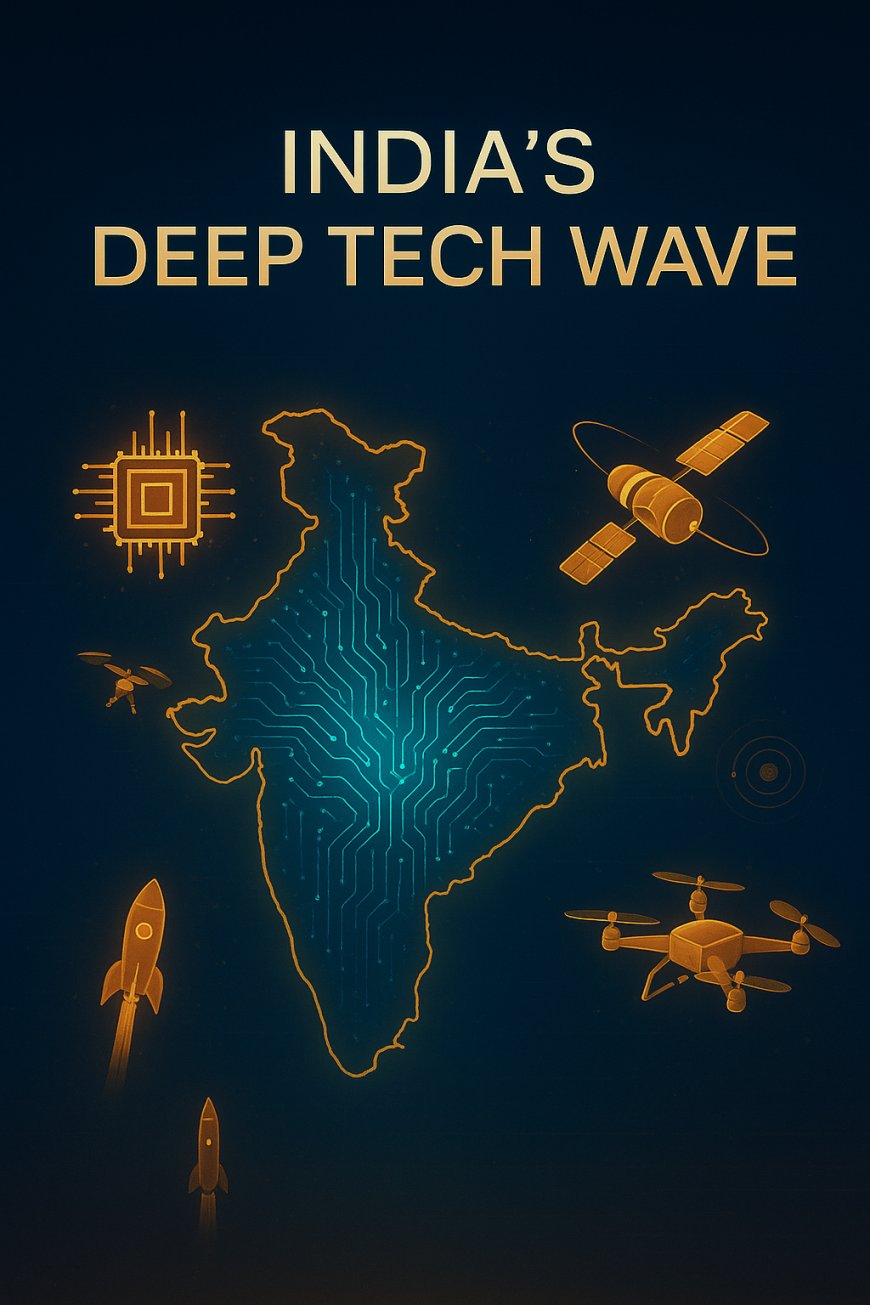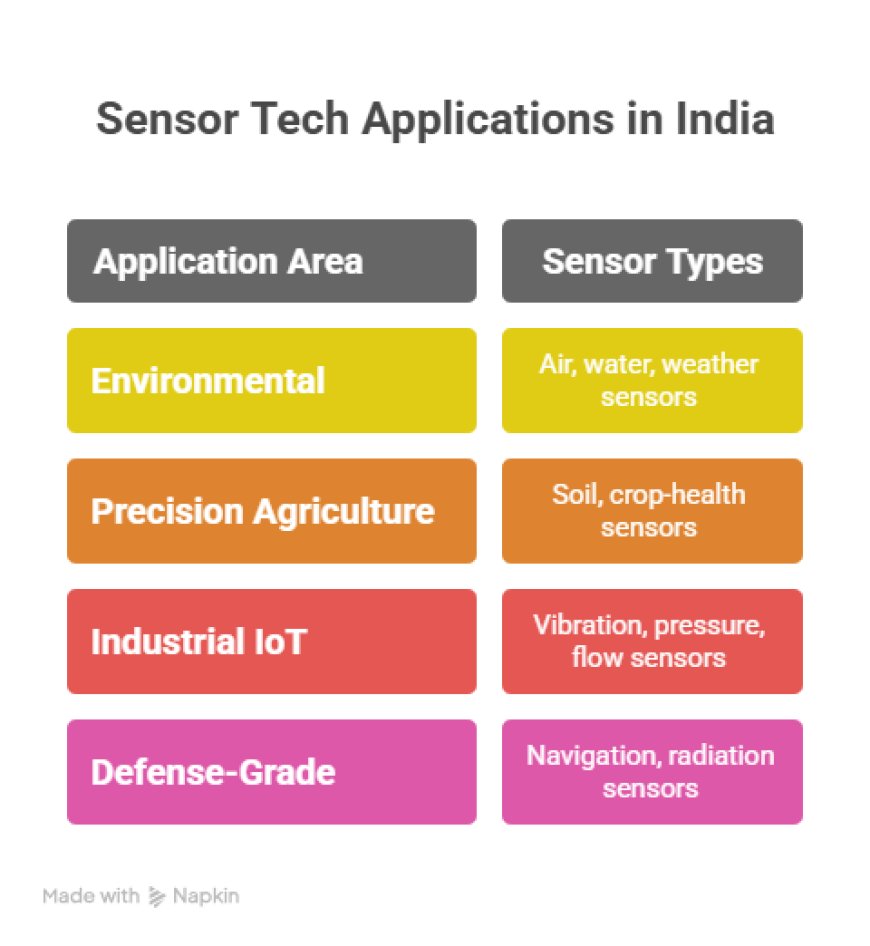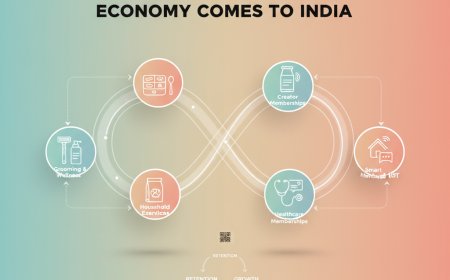India’s Deep Tech Wave — Sensors, Chips & SpaceTech
India is entering a deep-tech revolution—chips, sensors, drones, and space-tech. Discover how India is becoming the world’s next strategic innovation and manufacturing powerhouse.

India is entering one of its most transformative technology eras — a shift from being known primarily as an IT services and outsourcing hub to emerging as a deep-tech innovation powerhouse. This shift is not incremental; it is structural, strategic, and globally consequential.
Why this transition is happening now
- The world is undergoing massive supply chain realignment, pushing nations and enterprises to diversify beyond traditional manufacturing hubs.
- Recent chip shortages, geopolitical tensions, and rising security risks have highlighted the urgent need for trusted, sovereign technology ecosystems.
- Deep tech — unlike software — impacts defense, space, mobility, manufacturing, energy, and the very spine of national infrastructure.
Why deep tech matters for India
- National security: Semiconductor independence, secure drones, satellites, sensors, and strategic materials.
- Economic resilience: Reducing reliance on imports and building domestic manufacturing depth.
- Next-gen industries: EVs, robotics, advanced materials, AI hardware, quantum computing, and aerospace.
A maturing ecosystem
India’s deep-tech landscape is accelerating due to:
- ISRO opening doors to private players.
- DRDO collaborating extensively with startups and MSMEs.
- Growth of private R&D labs, hardware incubators, and university innovation centers.
- An emerging network of deep-tech accelerators, iDEX initiatives, and IIT/IISc labs fostering hardware innovation.
India’s ambition is clear: to move from being a global software contributor → to becoming a strategic global supplier of sensors, chips, drones, aerospace systems, and advanced hardware.
What Is Fueling India’s Deep Tech Wave?
India’s deep-tech surge is the result of a powerful combination of government policy, maturing talent, industry investment, and global supply chain realignment.

Government Push Toward High-Value Tech Sectors
India’s policy landscape has shifted decisively toward deep tech, driven by programs designed to boost hardware, space, and drone ecosystems:
- Semicon India Program supporting chip manufacturing, design, and packaging.
- PLI Schemes incentivizing production of electronics, telecom gear, solar modules, drones, batteries, and advanced components.
- Drone Policy Reforms enabling UAV manufacturing, pilot training, and drone-as-a-service (DaaS) startups to scale.
- Space Sector Reforms and IN-SPACe opening India’s space infrastructure to private players.
These policies signal a national priority: build sovereign capability in strategic tech sectors.
Rise of Highly Specialized Technical Talent
India’s talent pool is deepening beyond software into hardware and frontier sciences:
- IITs, IISc, and private tech universities introducing semiconductor, microelectronics, robotics, and AI hardware programs.
- Maker labs, fab labs, and prototyping centers becoming more accessible.
- A wave of returning Indian engineers bringing global semiconductor and aerospace expertise.
This has created the strongest hardware innovation workforce India has ever had.
Lower Hardware Manufacturing & Prototyping Costs
India offers a significant economic advantage for deep-tech manufacturing due to:
- Expanding electronics and precision manufacturing clusters across Gujarat, Karnataka, Tamil Nadu, Telangana, and Maharashtra.
- Affordable access to PCB fabrication, SMT lines, testing, and assembly.
- Competitive costs for robotics components, sensors, and mechanical parts.
This makes India attractive for early-stage prototyping as well as mass production.
Rising Corporate & Global Investor Interest
Indian and international investors are deploying more capital in deep tech than ever:
- Large corporates like Tata, Reliance, L&T, Adani entering semiconductors, aerospace, and robotics.
- Global VCs launching India-focused deep-tech and climate-tech funds.
- Increased partnerships with foreign chipmakers, satellite companies, and drone OEMs.
Deep tech is no longer “too risky” — it is now strategic.
Demand for Indigenous Technologies Post Global Supply Disruptions
The pandemic and geopolitical tensions exposed vulnerabilities in global supply chains. India’s response:
- Push for import substitution in chips, telecom, space systems, and defense.
- Growing appetite for trusted, secure, locally manufactured technologies.
- Global companies seeking supply chain diversification beyond China, with India as a preferred alternative.
The result: massive momentum toward building India’s own deep-tech backbone.
The Semiconductor Momentum: Fabs, Chip Design & Packaging
India’s semiconductor ambition is one of the most critical pillars of its deep-tech wave. The opportunities span manufacturing, chip design, packaging, and next-generation component innovation.
India’s Expanding Semiconductor Opportunity
Chips power every modern industry, and India is positioned to serve massive global demand in:
- Electric vehicles & mobility
- 5G & telecom
- IoT devices & smart sensors
- Defense and aerospace electronics
- Consumer electronics & appliances
The domestic market alone is expected to exceed hundreds of billions of dollars this decade.
Progress on Fabs & Manufacturing Infrastructure
India is taking the first serious steps toward building a semiconductor supply chain:
- Large-scale semiconductor fabs announced in Gujarat, supported by state and central incentives.
- Rapid progress in OSAT/ATMP facilities — the packaging and testing layer critical to chip production.
- Emerging clusters dedicated to microelectronics manufacturing and component assembly.
While full-scale fabs take years, ecosystem infrastructure is growing rapidly.
India’s Strength in Chip Design
India has long been a global leader in design and verification:
- Almost every major semiconductor company — Intel, Qualcomm, MediaTek, NVIDIA, AMD, Micron — operates large design centers in India.
- Thousands of Indian engineers work on SoC design, EDA tools, verification, and IP development.
- This gives India a competitive advantage in building indigenous chip IP and AI hardware.
Chip design is India’s fastest-growing deep-tech capabilities stack.
Rise of Semiconductor Startups
A new generation of hardware startups is emerging:
- IoT chipmakers designing energy-efficient microcontrollers.
- AI accelerator startups working on edge inference hardware.
- Sensor IC companies building indigenous automotive and industrial sensor chips.
- FPGA-based startups solving defense and industrial use cases.
These startups are transforming India from a chip design services hub → to a chip product ecosystem.
Challenges That Must Be Overcome
India’s semiconductor path faces structural obstacles:
- High capital intensity: Chip fabs require billions in investment and multi-year timelines.
- Supply chain dependencies: Materials, lithography machines, gases, and wafers still imported.
- Talent scaling: India must deepen its VLSI, fabrication, packaging, and nanoengineering workforce.
Despite challenges, the momentum is undeniable — India is positioning itself as a serious player in the global semiconductor map.
Sensor Tech: The Hidden Backbone of India’s Deep Tech Boom
Sensor technology is the silent force powering India’s next wave of deep-tech innovation. As industries modernize and automation rises, sensors have become essential to how machines, vehicles, factories, and systems “perceive” the world.
Why Sensor Tech Is Exploding in India
· Massive demand created by EVs, drones, robotics, wearables, smart factories, and precision farming.
· Transition from manual operations → sensor-driven, data-rich, automated workflows.
· Government policies encouraging domestic hardware innovation and imports substitution.

Indian Startups at the Forefront
Across multiple domains, startups are building indigenous sensor solutions tailored for Indian environments and price points:
Environmental Sensors
· Air quality sensors for cities, campuses, and industrial zones.
· Water quality monitoring systems for rivers, lakes, and treatment plants.
· Weather and micro-climate sensors for agriculture and climate resilience.
Precision Agriculture Sensors
· Soil moisture, nutrient, and pH sensors enabling data-driven farming.
· Crop-health sensors integrated with AI models for yield prediction.
· Low-power, rugged sensors designed for rural and outdoor conditions.
Industrial IoT Sensors
· Vibration, pressure, temperature, and flow sensors for Industry 4.0.
· Condition-monitoring sensors to predict equipment failures.
· Smart metering sensors to optimize energy and utility usage.
Defense-Grade Sensors
· Navigation, surveillance, and targeting sensors for aerial and land systems.
· Radiation, chemical, and biological sensors for national security.
· High-end imaging and night-vision sensor modules.
AI + Edge Computing → Real-Time Intelligence
Sensors are no longer standalone devices — they now integrate with edge processors and AI algorithms to:
· Detect anomalies instantly
· Trigger automated actions
· Reduce latency in mission-critical environments
· Enable predictive decision-making
This fusion is powering autonomous drones, smart vehicles, and intelligent factories.
Local Manufacturing = Strategic Autonomy
India is rapidly moving toward domestic sensor manufacturing with support from:
· PLI for electronics & IoT hardware
· Defense procurement policies favoring local sourcing
· Startup accelerators and corporate labs focusing on deep-tech hardware
This shift reduces dependence on China and Taiwan, while strengthening national security and supply chain resilience.
SpaceTech 2.0: India’s Private Space Revolution
India is undergoing a dramatic transformation in space technology — evolving from an ISRO-led ecosystem to a vibrant private space industry that is attracting global attention.
ISRO Opens the Gates: IN-SPACe
· IN-SPACe (Indian National Space Promotion and Authorization Centre) has become the catalyst for private participation.
· It allows startups to access ISRO infrastructure, testing facilities, and launch support.
· This collaboration accelerates innovation while reducing development costs for young companies.
A Startup Boom Across the Space Value Chain
India now hosts one of the world’s fastest-growing space startup ecosystems, with companies innovating across multiple segments:
Small Satellites
· Affordable, modular satellites for communication, imaging, and scientific purposes.
· Rapid prototyping cycles, miniaturized electronics, and low-latency communication.
Launch Vehicles
· Private companies building small and medium-lift launchers.
· Reusable rocket technologies to reduce cost-per-launch.
· India targeting the global small-satellite launch market.
Earth Observation Platforms
· High-resolution imaging for agriculture, climate analysis, disaster early-warning, and urban planning.
· Multispectral and hyperspectral imaging capabilities.
Space Data Analytics
· AI-driven platforms turning raw satellite data into insights for governments, enterprises, and global agencies.
· Applications include crop forecasting, infrastructure intelligence, and climate-risk modelling.
India’s Edge: Low-Cost, High-Reliability Launch Hub
Leveraging decades of ISRO engineering excellence and cost efficiency:
· India offers some of the world’s most economical commercial launch services.
· This is attracting global satellite companies seeking reliable, affordable access to space.
Commercial Opportunities Across Sectors
The SpaceTech boom is unlocking massive business potential in:
· Agriculture: Crop mapping, irrigation optimization, soil insights.
· Climate: Carbon tracking, heat islands, deforestation monitoring.
· Defense: Surveillance, border intelligence, secure communication.
· Disaster Management: Flood mapping, cyclone alerts, rapid damage assessment.
Drone & Autonomous Flight Systems: The Next Frontier
India is entering a new era of airborne innovation, driven by progressive drone policy reforms and rapid advances in autonomous systems. With the government easing regulations and offering incentives, the drone ecosystem is evolving from manual quadcopters to intelligent, AI-powered aerial systems.
Drone Policy Liberalization → A New Hardware Startup Wave
· The Drone Rules 2021 drastically reduced barriers for manufacturing, testing, and operating drones.
· PLI schemes for drone components are encouraging local production of motors, batteries, frames, and sensor modules.
· Startups are emerging across design, manufacturing, software, and payload systems.
Applications Transforming Key Industries
Drones are moving from niche technology to mainstream industrial tools across sectors:
Logistics & Delivery
· Last-mile delivery of medicines, groceries, and e-commerce packages.
· Trials by leading logistics companies in remote and urban regions.
· Potential to cut delivery time by over 70% in inaccessible areas.
Agriculture
· Drone spraying for fertilizers, pesticides, and micronutrients.
· Autonomous mapping for crop health, soil moisture, and yield estimation.
· Cost-effective alternative to manual spraying and ground-based machinery.
Defense Surveillance
· Border monitoring using long-range UAVs.
· Real-time imaging and thermal sensing for tactical operations.
· Indigenous systems reducing import dependency on foreign drone tech.
Infrastructure Inspection
· Power lines, solar farms, pipelines, and large industrial sites.
· High-resolution imaging reduces manpower risk and improves inspection accuracy.
· Digital twins created using aerial mapping data for predictive maintenance.
Rise of Autonomous UAV Systems
The future of drones is autonomous — capable of flying, mapping, and making decisions without human control. This is being powered by:
· Onboard AI models for navigation and obstacle avoidance
· Computer vision systems enabling object detection and tracking
· Sensor fusion combining LiDAR, GPS, radar, and IMU data
· Edge computing modules for real-time decision-making
These technologies are accelerating the shift from manual piloting to fully automated missions across agriculture, defense, and enterprise operations.
Collaborations Driving the Ecosystem
· Joint R&D projects between the Ministry of Defense, startups, universities, and engineering institutions.
· Defense corridors in Tamil Nadu and UP offering testing zones and manufacturing incentives.
· Partnerships with global aerospace firms for co-development and technology transfer.
Drones and autonomous flight systems are becoming a flagship sector in India’s deep-tech journey.
National Security & Strategic Technology Independence
As global tensions reshape supply chains and technological dependencies, India is making strategic moves to secure its future in critical technologies. Deep tech is no longer just an economic opportunity — it’s a national security priority.
Reducing Reliance on China
India is actively working to minimize dependence on Chinese imports, particularly in:
· Electronics and semiconductor components
· Sensors, LiDAR, and imaging modules
· Drone motors, flight controllers, and batteries
· Telecom equipment and networking hardware
Strengthening domestic alternatives ensures resilience during geopolitical disruptions.
The Need for Trusted Supply Chains
Secure and trustworthy supply chains are essential for sectors such as:
· Defense: advanced electronics, UAVs, missile guidance systems.
· Aerospace: satellite components, propulsion systems, avionics.
· Telecom: 5G/6G infrastructure, secure communication hardware.
· Electric Vehicles: power electronics, battery management systems.
Building these capabilities domestically reduces vulnerability to export bans and supply shocks.
India’s Push for Sovereign Capabilities
India is investing aggressively to build end-to-end self-reliance in strategic technologies:
· Semiconductors: chip fabrication, OSAT units, and indigenous microprocessor design.
· Satellites: small-satellite manufacturing, space-grade electronics, launch capacity.
· Navigation Systems: strengthening NavIC as a reliable alternative to GPS.
· Quantum Technologies: secure communication and advanced computing research.
· Defense Electronics: indigenous radars, communication systems, and sensor suites.
These initiatives not only protect national security but also position India as a global technology supplier, not just a consumer.
The Emerging Deep-Tech Startup Ecosystem
India’s deep-tech startup ecosystem is entering a breakout phase, driven by innovation in hardware, frontier science, and research-led entrepreneurship. Unlike traditional IT-led startups, these companies are building foundational technologies that power national security, future industries, and global competitiveness.
Mapping the Deep-Tech Landscape
Semiconductor & Chip Design
· Startups building IoT microcontrollers, AI accelerators, and sensor ICs.
· India becoming a global hub for chip design centers and verification labs.
· Rise of companies developing indigenous processors and low-power chipsets.
Robotics & Drones
· Industrial robots for manufacturing, logistics, and inspection.
· Agricultural drones, surveillance UAVs, and autonomous flying systems.
· Robust hardware engineering talent emerging in Bangalore, Chennai, and Hyderabad.

SpaceTech
· Startups working on small satellites, reusable rockets, propulsion, and space-grade materials.
· Earth observation and satellite data analytics powering agriculture, logistics, and climate monitoring.
· Private players participating in launch missions, debris tracking, and global space services.
Quantum Computing
· Companies developing quantum simulators, quantum-safe encryption, and early-stage hardware stacks.
· Strong academic collaboration with IISc, IIT-Madras, and government quantum missions.
Advanced Materials
· Innovations in graphene, semiconductor materials, nanomaterials, and composites.
· Applications across EV batteries, aerospace components, and flexible electronics.
AI + Edge Hardware
· Startups integrating AI with edge computing for real-time processing.
· Designs for edge chips, FPGA-based accelerators, and specialized ML hardware.
· Use cases across retail automation, surveillance, EVs, logistics, and healthcare.
Accelerators & Innovation Programs Driving Momentum
· iDEX (Innovation for Defence Excellence): Funding and rapid prototyping for defense and dual-use technologies.
· T-Hub: One of the largest deep-tech accelerators enabling AI, drones, and semiconductor innovation.
· IIT/ISRO Incubators: Hardware labs, space technology programs, and partnerships driving high-tech startup creation.
· Maker spaces & fab labs: Growing access to prototyping tools for PCBs, sensors, and robotics.
A Surge in Patents & Deep-Tech Exports
· India’s patent filings in deep tech—especially electronics, satellites, and robotics—are rising exponentially.
· Export of drone components, space-tech services, and chip design IP is increasing global visibility.
· India is transitioning from a “services destination” to a strategic technology exporter.
The ecosystem is maturing into a powerful engine that can reshape India’s position in the global technology order.
Challenges on the Road Ahead
Despite the momentum, India’s deep-tech journey faces structural barriers that must be addressed to compete with global leaders.
Long R&D Cycles & High Capital Requirements
· Deep-tech startups require years of research before commercialization.
· Hardware prototyping, chip fabrication, and testing are expensive.
· Funding cycles in India still favor faster, software-led business models.
Shortage of Skilled Semiconductor & Robotics Talent
· Limited availability of VLSI designers, fabrication specialists, and robotics engineers.
· Academia-industry gap in advanced electronics and high-precision manufacturing.
· Competition from global markets pulling top-tier Indian talent abroad.
Dependence on Imported Equipment & Materials
· India imports most semiconductor-grade equipment, wafers, and chemicals.
· Precision tools for drones, sensors, and robotics remain capital-intensive.
· Building end-to-end hardware supply chains will take time.
Regulatory Complexities in Defense & Space
· Licensing, compliance, and approval cycles can be slow for dual-use technologies.
· Export control regulations create constraints for startups wanting global markets.
· Testing ranges and secure facilities require faster access and expansion.
Global Competition
India faces formidable competitors across deep-tech verticals:
· US → AI chips, advanced robotics, quantum computing
· Taiwan, Korea → Semiconductor fabs, chip packaging
· China → Sensors, drones, telecom hardware
· Japan, EU → Space systems, industrial robotics
India must accelerate R&D, build domestic supply chains, and scale startups quickly to stay competitive.
The Opportunity: India as the World’s Next Deep-Tech Powerhouse
India is uniquely positioned to emerge as a global deep-tech leader—powered by scale, talent, policy shifts, and geopolitical tailwinds. What was once a services-led economy is now building the foundational technologies of the future.
India’s Demographic + Cost Advantage
· A young engineering workforce capable of building hardware at scale.
· Significantly lower R&D and prototyping costs compared to the US, EU, or East Asia.
· Growing pool of semiconductor designers, aerospace engineers, and AI researchers.
· Increasing availability of fabrication labs, test facilities, and specialized institutes.
A Strategic Alternative to China
Global companies are actively seeking to diversify their supply chains—and India is emerging as the top contender due to:
· Political stability and strong international partnerships.
· Incentivized manufacturing through PLI programs.
· A rapidly maturing hardware ecosystem.
· Trusted governance and global compliance standards.
India can become the world’s go-to hub for:
· Electronics manufacturing
· Sensor fabrication
· Drone and aerospace components
· Satellite and space-tech services
Deep-Tech as India’s Next Export Engine
India’s potential export strengths include:
· Sensors: Environmental, agricultural, industrial, and defense-grade sensors.
· Drones: Logistics UAVs, agricultural drones, surveillance systems, and autonomous platforms.
· Chips: IoT microchips, AI edge chips, automotive semiconductors, and specialized processors.
· Satellites: Small satellites, payload systems, and launch services.
These exports position India not just as a market—but as a global supplier of critical technologies powering climate, security, mobility, and communication systems worldwide.
Aligned With National Priorities
India’s deep-tech surge is fully aligned with long-term national goals:
· Security: Reducing dependence on foreign technology for defense and aerospace.
· Self-reliance: Building sovereign capabilities in electronics, sensors, and space systems.
· Industry 4.0: Enabling automation, smart manufacturing, and intelligent infrastructure.
· Economic leadership: Positioning India as a global innovation and manufacturing hub.
This is more than an industry trend—it’s a national transformation.
Conclusion
India stands at an inflection point—technology, talent, policy, and global demand are converging to create a once-in-a-generation opportunity. The country is moving beyond software dominance into deep, foundational technologies that will shape global industries for decades.
Deep tech is not optional for India—it’s strategic.
· Sensors will power smart factories, EVs, climate solutions, and national security.
· Chips will define India’s role in electronics, mobility, telecom, and AI.
· Drones will reshape logistics, agriculture, and defense.
· Space-tech will put India at the center of global satellite services and climate intelligence.
This is the beginning of a new era—one where India becomes a creator, manufacturer, and exporter of world-class technology.
The next trillion-dollar opportunity isn’t in software.
It’s in deep tech—and India is ready.
What's Your Reaction?
 Like
0
Like
0
 Dislike
0
Dislike
0
 Love
0
Love
0
 Funny
0
Funny
0
 Angry
0
Angry
0
 Sad
0
Sad
0
 Wow
0
Wow
0

























































































































































































